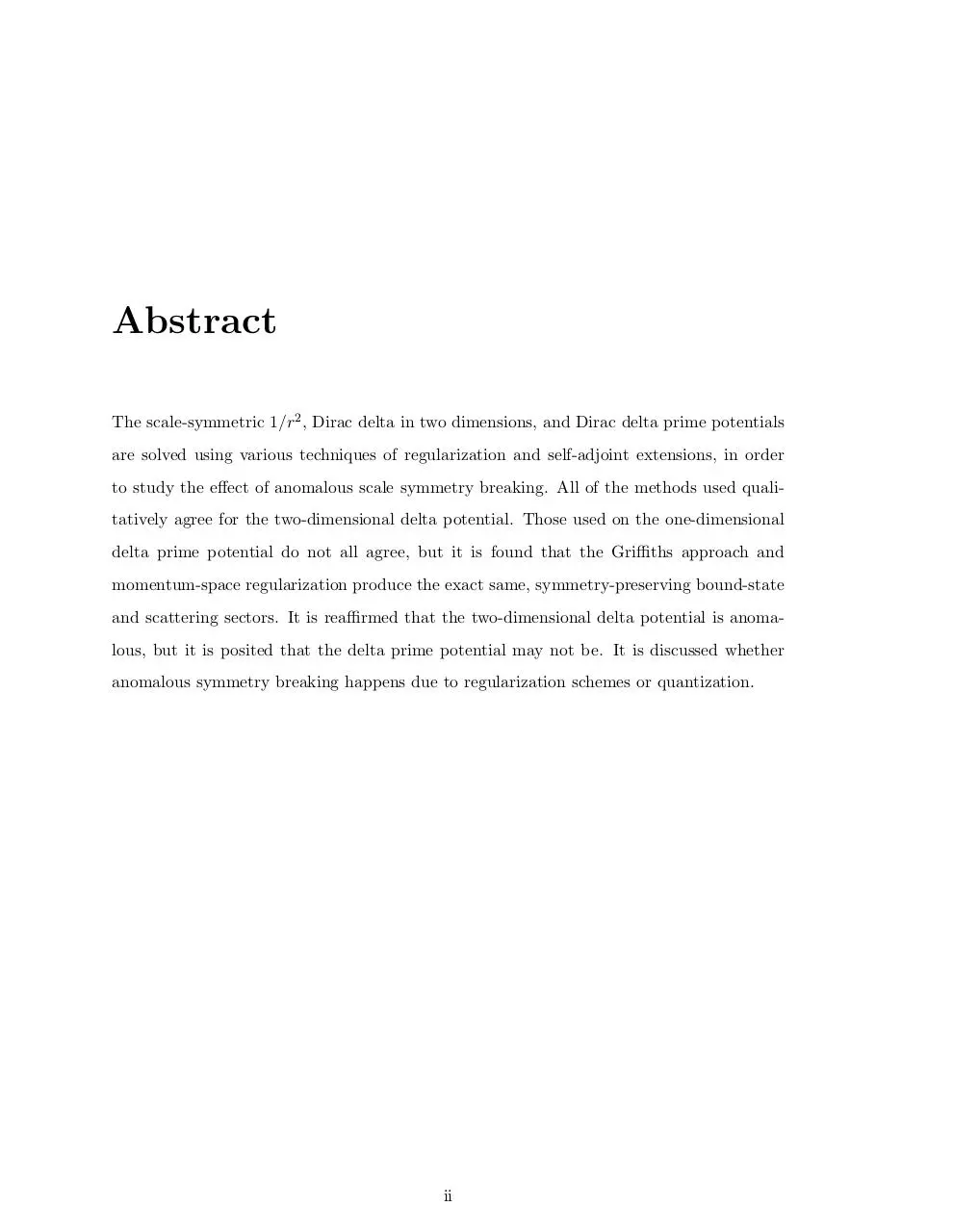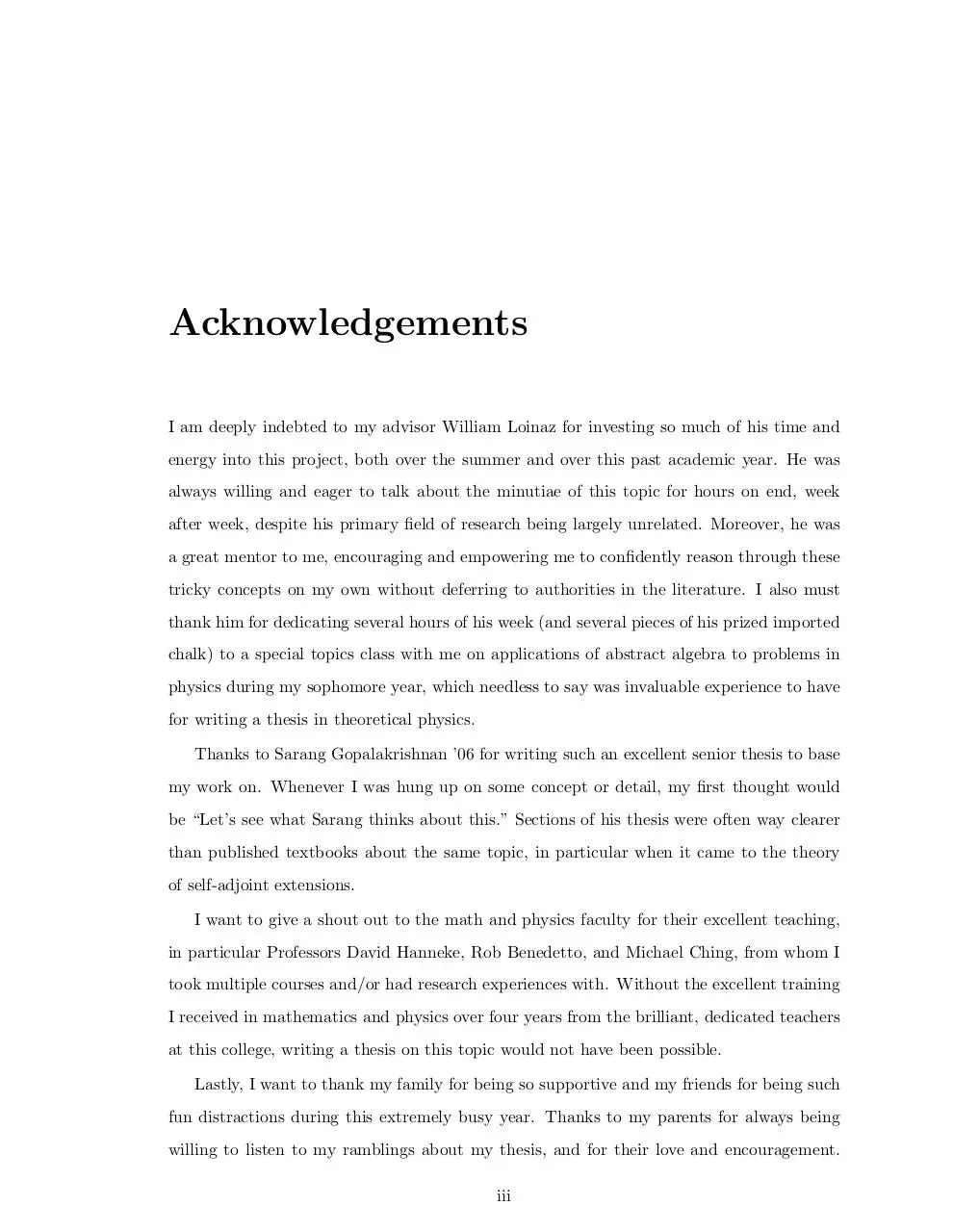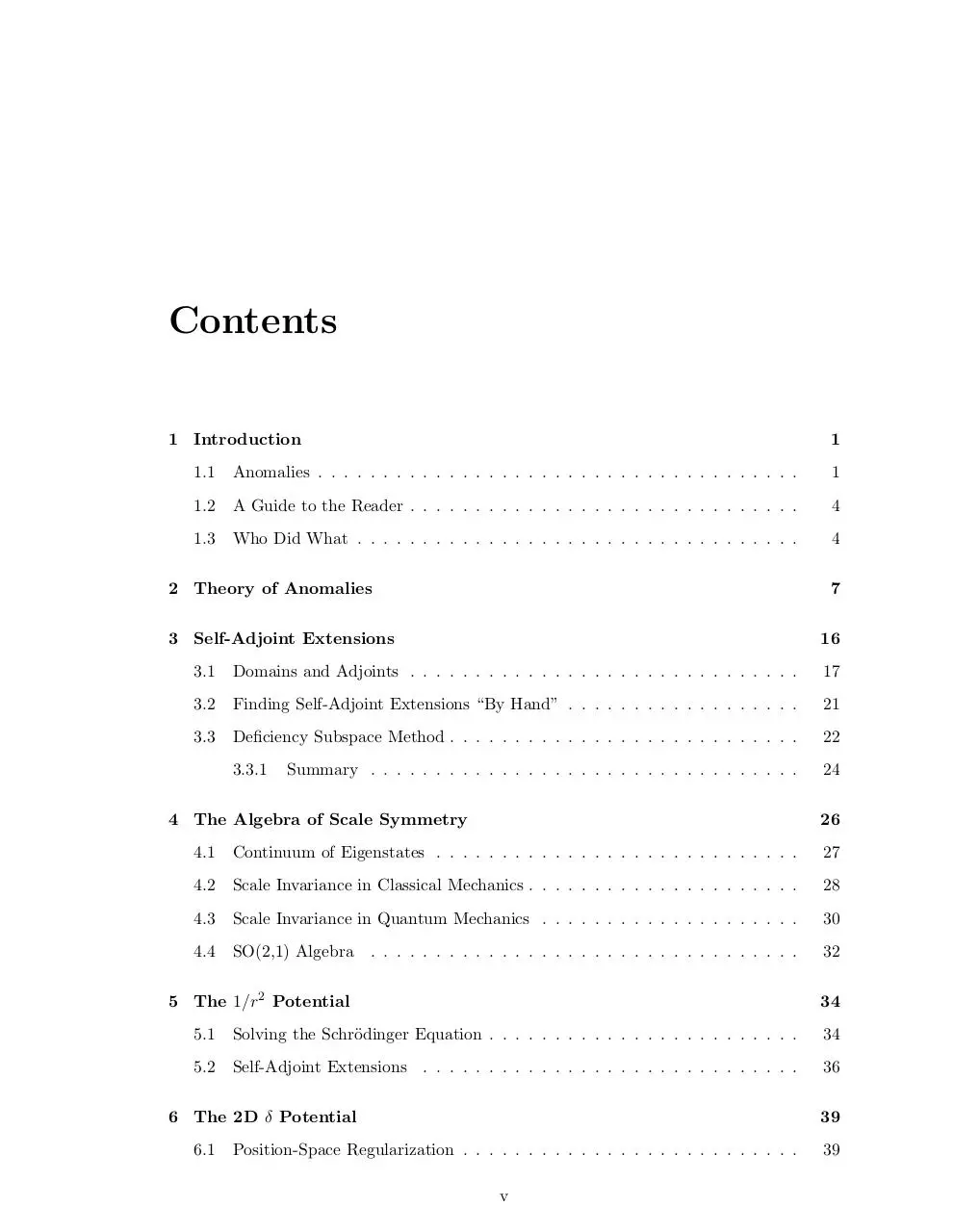OEM Thesis (PDF)
File information
This PDF 1.3 document has been generated by TeX / Mac OS X 10.10.4 Quartz PDFContext, and has been sent on pdf-archive.com on 25/11/2015 at 19:29, from IP address 174.99.x.x.
The current document download page has been viewed 836 times.
File size: 1.26 MB (108 pages).
Privacy: public file





File preview
Anomalies in Quantum
Mechanics
Owen Edward Marschall
April 17, 2015
Submitted to the
Department of Physics and Astronomy
of Amherst College
in partial fulfillment of the requirements
for the degree of
Bachelor of Arts with honors
Faculty Advisor: Professor William Loinaz
Copyright c 2015 Owen Edward Marschall
Abstract
The scale-symmetric 1/r2 , Dirac delta in two dimensions, and Dirac delta prime potentials
are solved using various techniques of regularization and self-adjoint extensions, in order
to study the e↵ect of anomalous scale symmetry breaking. All of the methods used qualitatively agree for the two-dimensional delta potential. Those used on the one-dimensional
delta prime potential do not all agree, but it is found that the Griffiths approach and
momentum-space regularization produce the exact same, symmetry-preserving bound-state
and scattering sectors. It is reaffirmed that the two-dimensional delta potential is anomalous, but it is posited that the delta prime potential may not be. It is discussed whether
anomalous symmetry breaking happens due to regularization schemes or quantization.
ii
Acknowledgements
I am deeply indebted to my advisor William Loinaz for investing so much of his time and
energy into this project, both over the summer and over this past academic year. He was
always willing and eager to talk about the minutiae of this topic for hours on end, week
after week, despite his primary field of research being largely unrelated. Moreover, he was
a great mentor to me, encouraging and empowering me to confidently reason through these
tricky concepts on my own without deferring to authorities in the literature. I also must
thank him for dedicating several hours of his week (and several pieces of his prized imported
chalk) to a special topics class with me on applications of abstract algebra to problems in
physics during my sophomore year, which needless to say was invaluable experience to have
for writing a thesis in theoretical physics.
Thanks to Sarang Gopalakrishnan ’06 for writing such an excellent senior thesis to base
my work on. Whenever I was hung up on some concept or detail, my first thought would
be “Let’s see what Sarang thinks about this.” Sections of his thesis were often way clearer
than published textbooks about the same topic, in particular when it came to the theory
of self-adjoint extensions.
I want to give a shout out to the math and physics faculty for their excellent teaching,
in particular Professors David Hanneke, Rob Benedetto, and Michael Ching, from whom I
took multiple courses and/or had research experiences with. Without the excellent training
I received in mathematics and physics over four years from the brilliant, dedicated teachers
at this college, writing a thesis on this topic would not have been possible.
Lastly, I want to thank my family for being so supportive and my friends for being such
fun distractions during this extremely busy year. Thanks to my parents for always being
willing to listen to my ramblings about my thesis, and for their love and encouragement.
iii
Thanks to Nicole Chi for her endless supply of co↵ee, snacks, and laughs; and to the Homie
Patrol for their constant vigilance.
iv
Contents
1 Introduction
1
1.1
Anomalies . . . . . . . . . . . . . . . . . . . . . . . . . . . . . . . . . . . . .
1
1.2
A Guide to the Reader . . . . . . . . . . . . . . . . . . . . . . . . . . . . . .
4
1.3
Who Did What . . . . . . . . . . . . . . . . . . . . . . . . . . . . . . . . . .
4
2 Theory of Anomalies
7
3 Self-Adjoint Extensions
16
3.1
Domains and Adjoints . . . . . . . . . . . . . . . . . . . . . . . . . . . . . .
17
3.2
Finding Self-Adjoint Extensions “By Hand” . . . . . . . . . . . . . . . . . .
21
3.3
Deficiency Subspace Method . . . . . . . . . . . . . . . . . . . . . . . . . . .
22
3.3.1
24
Summary . . . . . . . . . . . . . . . . . . . . . . . . . . . . . . . . .
4 The Algebra of Scale Symmetry
26
4.1
Continuum of Eigenstates . . . . . . . . . . . . . . . . . . . . . . . . . . . .
27
4.2
Scale Invariance in Classical Mechanics . . . . . . . . . . . . . . . . . . . . .
28
4.3
Scale Invariance in Quantum Mechanics . . . . . . . . . . . . . . . . . . . .
30
4.4
SO(2,1) Algebra . . . . . . . . . . . . . . . . . . . . . . . . . . . . . . . . .
32
5 The 1/r2 Potential
34
5.1
Solving the Schr¨
odinger Equation . . . . . . . . . . . . . . . . . . . . . . . .
34
5.2
Self-Adjoint Extensions . . . . . . . . . . . . . . . . . . . . . . . . . . . . .
36
6 The 2D
6.1
Potential
39
Position-Space Regularization . . . . . . . . . . . . . . . . . . . . . . . . . .
v
39
6.2
Momentum-Space Regularization . . . . . . . . . . . . . . . . . . . . . . . .
45
6.2.1
1D
Potential . . . . . . . . . . . . . . . . . . . . . . . . . . . . . .
46
6.2.2
2D
Potential . . . . . . . . . . . . . . . . . . . . . . . . . . . . . .
50
Self-Adjoint Extensions Method . . . . . . . . . . . . . . . . . . . . . . . . .
53
6.3.1
Free Particle on the Unpunctured Plane . . . . . . . . . . . . . . . .
54
6.3.2
Free Particle on the Punctured Plane . . . . . . . . . . . . . . . . .
57
6.4
Dimensional Regularization . . . . . . . . . . . . . . . . . . . . . . . . . . .
58
6.5
Path-Integral Approach . . . . . . . . . . . . . . . . . . . . . . . . . . . . .
61
6.6
The Classical Problem . . . . . . . . . . . . . . . . . . . . . . . . . . . . . .
63
6.7
Interpretation as Anomaly . . . . . . . . . . . . . . . . . . . . . . . . . . . .
65
6.3
7 The 1D
0
Potential
68
7.1
Position-Space Regularization . . . . . . . . . . . . . . . . . . . . . . . . . .
69
7.2
Momentum-Space Regularization . . . . . . . . . . . . . . . . . . . . . . . .
72
7.3
Griffiths Method . . . . . . . . . . . . . . . . . . . . . . . . . . . . . . . . .
77
7.4
Self-Adjoint Extensions . . . . . . . . . . . . . . . . . . . . . . . . . . . . .
80
7.4.1
Self-Adjointness of 1D
. . . . . . . . . . . . . . . . . . . . . . . . .
81
7.4.2
Self-Adjointness of 1D
. . . . . . . . . . . . . . . . . . . . . . . . .
82
7.4.3
Deficiency Subspaces . . . . . . . . . . . . . . . . . . . . . . . . . . .
83
Interpretation . . . . . . . . . . . . . . . . . . . . . . . . . . . . . . . . . . .
84
7.5
0
8 Applications and Conclusion
85
8.1
Theoretical Applications . . . . . . . . . . . . . . . . . . . . . . . . . . . . .
85
8.2
Experimental Applications . . . . . . . . . . . . . . . . . . . . . . . . . . . .
86
8.3
Conclusion
. . . . . . . . . . . . . . . . . . . . . . . . . . . . . . . . . . . .
87
8.4
Future Work . . . . . . . . . . . . . . . . . . . . . . . . . . . . . . . . . . .
88
A 1D ’ Calculation Details
90
B Self-Adjoint Extensions On R \ {0}
95
Bibliography
98
vi
Chapter 1
Introduction
1.1
Anomalies
An anomaly is the breaking of a classical symmetry that occurs in the corresponding quantum theory. Anomalies occur frequently in the context of quantum field theory and often
have consequences for a theory such as the non-conservation of currents, the emergence of
new types of particles, or the introduction of a mass scale [47]. Anomalies in quantum field
theory have been studied for decades and are relatively well-understood [31].
But there has more recently been a surge of interest in quantum mechanical anomalies,
for a number of reasons. One reason is strictly pedagogical: given how important anomalies
are in quantum field theory but how inaccessible this subject is to undergraduates, many
authors have taken to finding examples in ordinary quantum mechanics that can help build
students’ intuition for the concept in a simpler context [30].
The more important reason, however, is that ordinary quantum mechanics has been
found to be useful as a simplifying approximation to quantum field theories [44]; this is the
central idea behind the e↵ective field theory program. Quantum mechanics itself can be
thought of as a 0 + 1-dimensional field theory, and the Fock Space formalism of QFT, which
is used to allow for indefinite numbers of particles, is built up from quantum mechanical
Hilbert spaces [49]. Therefore phenomena in quantum field theory ought to have analogues
in quantum mechanics.
As a part of the e↵ective field theory program, many tools and ideas from quantum field
theory such as regularization, renormalization, and dimensional transmutation are being
1
applied to singular potentials in ordinary quantum mechanics [21]. These processes usually
involve getting rid of some unwanted infinity—even if it appears very naturally in a calculation—or inserting dimensions into an originally dimensionless parameter. It is assumed that
the infinity is unphysical and that it instead represents some inadequacy of the theory that
needs to be fixed. Since these techniques are responsible for the creation of anomalies in
quantum field theory, it is not surprising that bringing them into quantum mechanics would
also bring about anomalous symmetry breaking. These quantum mechanical anomalies have
become interesting objects of study in their own right.
The only classical symmetry that has found to be broken in quantum mechanics is scale
symmetry, which is essentially the property of a potential having only dimensionless couplings. A consequence is that there is no dimensional parameter available to set the energy
scale of, say, a bound state or energy dependence in a scattering phase shift. Therefore,
this symmetry can be shown to be broken through what is called the anomalous emergence
of a bound state—and this bound-state energy can be a reference for the anomalous energy
dependence of scattering observables, too. These ideas will be more fully fleshed out in
Chapter 4.
On the first pass through calculating the spectrum of a scale symmetric potential, we
usually find that there is no bound state sector, but we can sometimes force a bound
state on the problem through techniques of regularization and renormalization, which are
required for the problem to make well-defined physical predictions. This, in a nutshell, is
the quantum mechanical anomaly. The Dirac delta potential in two dimensions and the
1/r2 potential in any number of dimensions, both scale-symmetric potentials, have been
presented in the literature as examples of the quantum mechanical anomaly [1], [9], [30],
[33].
Invariably, the derivation of a quantum mechanical anomaly involves at some point in
the calculation a kind of “fudging,” as one might call it, e.g. redefining certain limits in
the middle of the problem, allowing a coupling constant to approach 0, or “cutting o↵”
an integral’s bounds before infinity. Although it may seem shocking and distasteful to
someone outside the field, such “fudging” can be well-motivated and sensible. In quantum
field theory, techniques of regularization and renormalization are necessary to deal with the
2
artificial infinities that frequently arise due to the infinite degrees of freedom in the theory
[37].
A simple example of renormalization is choosing, after the fact, to have a free-scalar-field
Hamiltonian’s eigenvalues correspond to energy density rather than energy, since spacetime has infinite volume. Such a divergence is known as an infrared divergence, and it
is fixed simply by dividing through by the volume of space V and taking the limit V !
1 [37]. Another type of renormalization involves cutting o↵ high-energy, short-distance
oscillation modes in the field theory, because we assume that at some energy/length scale,
the field theory breaks down. This is called an ultraviolet divergence, which arose because
we presumed the field theory to be valid for all length scales [37].
This same mindset of trying to eliminate all unwanted infinities at all cost has been
adopted into quantum mechanics. Therefore, it should not be surprising that we would
encounter the anomalous breaking of scale-symmetry, since the lack of a bound state often
results from the bound-state energy blowing up to
1 during a regularization procedure
that respects the scale symmetry. If we decide that such an infinity is unacceptable, then
of course a bound state will emerge.
So on the one hand, these quantum mechanical anomalies result from the application of
well-respected and well-understood techniques of renormalization borrowed from quantum
field theory, used to deal with the artificial problem of having infinitely many degrees of
freedom. But on the other, there’s this troubling feeling that such an approach would
necessitate an anomaly in any case, regardless of the particulars of the problem. If we were
going to get rid of any infinity we encountered all along, then how would we not break scale
symmetry? What would it mean for a scale-symmetric potential to not have an anomaly?
These are the kinds of questions we will attempt to answer. How should we view these
examples of anomalies in quantum mechanics? Are they truly outliers, as the terminology
“anomaly” suggests, or did theorists find them only because they were determined to find
them?
As a side question, we will also consider the one-dimensional delta prime potential—that
is, the derivative of the delta potential, whatever that means—which is scale symmetric but
hasn’t yet been entered into the literature’s canon of quantum mechanical anomalies. By
3
Download OEM Thesis
OEM_Thesis.pdf (PDF, 1.26 MB)
Download PDF
Share this file on social networks
Link to this page
Permanent link
Use the permanent link to the download page to share your document on Facebook, Twitter, LinkedIn, or directly with a contact by e-Mail, Messenger, Whatsapp, Line..
Short link
Use the short link to share your document on Twitter or by text message (SMS)
HTML Code
Copy the following HTML code to share your document on a Website or Blog
QR Code to this page

This file has been shared publicly by a user of PDF Archive.
Document ID: 0000317411.